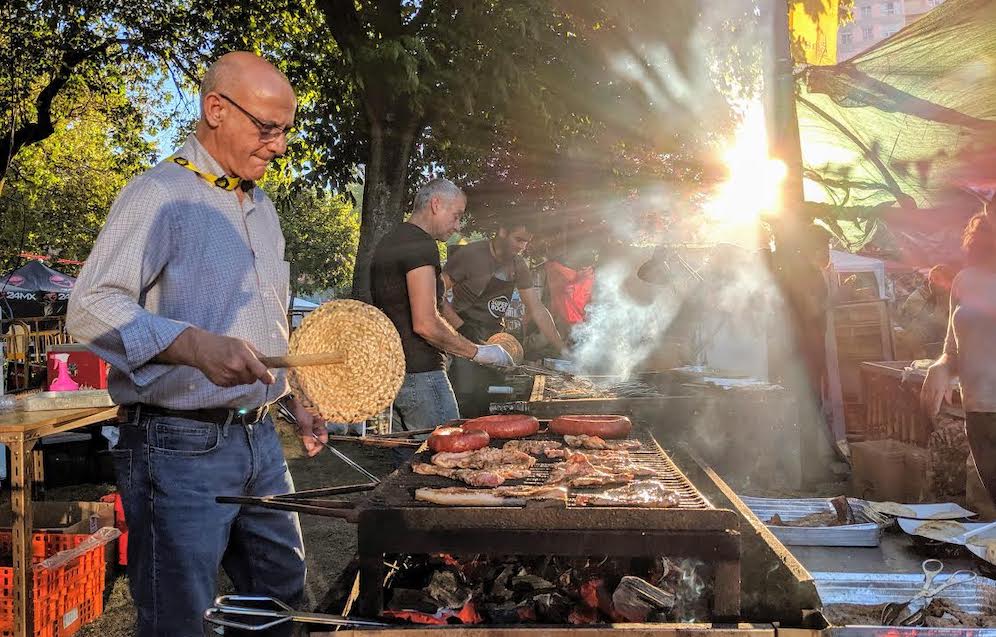(Editor’s note: The Festival of Santo Antonio (also known as Festas dos Santos Populares or Popular Saints’ Festival), takes place every year in Lisbon throughout the entire month of June.)

Santos Populares Alleyway leading up to Arraial Santa Catarin (All photos by Mariam Thaler unless noted)
Lisbon has five seasons, the usual four and the fifth, its very own Santos Populares … far and away my favourite. Come June and the city turns into one big party, or rather many parties, called arraial (plural:arraiais), in every corner of the city.
If you follow the smell of grilled sardines wafting through the small streets of Lisbon on almost any evening of the month, you most likely very soon will hear loud Portuguese music that continues to guide you until you see colourful garlands (right) above your head crisscrossing the alleyway you are on.
At this point chances are you would already have found yourself amidst a happy crowd of Lisbonners, tourists and expats, all partying through the night. It is the celebration of Lisbons’ popular saints (ergo Santos Populares) – above all Lisbon’s patron saint, Santo António – that seeds this outburst of hedonistic savoir vivre.
Last year, after six whole years of skimming the festivities, I finally decided to experience Santos Populares to its fullest, immersing myself into the Roman Catholic traditions as well as the parties to collect tips and tricks for anyone who is up for enjoying the bliss of this unique festival.
A tough job, but somebody has to do it
The first parties start mushrooming in the beginning of June and mostly take place on the weekends or days close to the weekends.
It can be hard to choose, since there is so much happening and each party has its own character.
The good thing is, of course, that you have a whole month to visit one after the other and on a good evening in the city center you can hop from one party to the next. However, each of the evenings has its own programme, often with a different band playing and some parties only take place during the first or second half of the month.
So, if you want to approach this in all seriousness, it might be worth checking out each arraial’s programme. It is not difficult to find out the dates and places for each of the arraiais.
The webpage Cartazculturallisboa can be very helpful for this purpose.
Further enquiries, however, might mean some detective work and you might want to channel your inner Sherlock and google away to find the programme of each of the parties. Alternatively, you could keep your eyes open at your next city stroll and you will surely find some posters indicating what the nights of June have in store for you.

My small hand-selected collection of arraiais:
The lavish:
The arraial de São Miguel is one of the most popular arraiais in Lisbon. Located in Alfama, it attracts huge crowds. The many food and drink stalls give it the atmosphere of a large popular fair, the live music makes the tipsy crowd sway as one. If you don’t want to fully dive into the crowd at the main square, you can also just enjoy the atmosphere and eat and drink your way through the alleys.
The alternative:
The arraial at Largo da Rosa in Mouraria attracts a younger, more alternative crowd with different kinds of live music and DJ sets. It’s one of the smaller, cosy arraiais.
The cosy:
It might be surprising, but one of the cosiest arraiais is found in Lisbon’s party quarter, in Bairro Alto. The Santa Catarina arraial is nested in a small backyard and is one of those parties welcoming everyone from teenagers to best-agers.
The traditional:
The arraial de Santo Amaro in Alcântara is one of those parties, where you truly sense the whole neighbourhood coming together. It has a big stage welcoming different live music acts, different neighbourhood associations present themselves in small stalls, offering small tombolas, where you might win an old flower vase or a second-hand book. If you are there, make sure to also pay a short visit to Academia de Santo Amaro, an old socio-cultural association close-by, offering food and music in a family atmosphere.
The unexpected:
One of the most beautiful experiences during Santos Populares is to accidentally stumble into an arraial when you least expect it. You might be enjoying an evening walk and find this hidden gem of a party. This attracts everyone in the neighbourhood, and is where you’d see a granny dance with her granddaughter, where families and friends sit together on tables eating sardines, bifanas (a Portuguese pork steak sandwich) and Chouriço (a lipsmacking grilled sausage), drinking beer and chatting away.
In case you want to follow in my own accidental footsteps, you might want to check out the small, authentic and unpretentious Arraial dos Combatentes in Estrela.

Must dos:
• Go out on 12 June, the night of Santo António. This is the night when the city erupts. The night opens with a huge parade at Avenida da Liberdade. Each part of town is represented there, they wear the most colourful thematic costumes (above) and present a choreography. I do enjoy the atmosphere around the parade, the anticipation just before it starts, seeing the marching groups excitedly waiting in the streets leading down to Marquês Pombal, people gathering along the Avenida. And yet, unless you manage to get a seat in one of the stands along the Avenida or unless you follow the live transmission on national tv, you will not catch a good sight of the elaborate choreographies. In between the stands the groups only walk silently.
Thus maybe you want to start your evening with a casual stroll along the Avenida, but don’t get disappointed if the march itself is a little underwhelming for the passers-by. The parties all throughout the city however, are everything but underwhelming.
Just allow yourself to be taken by the night and no matter in which direction you start walking, you will stumble into a party.
Some might be very crowded, others less so. Just follow wherever your fancy takes you.
• Buy a manjerico for your beloved one. All around town – even in supermarkets – you’ll find these cute roundly shaped basil plants in little pots. They often have a small colourful flag with a romantic poem stuck into them and are given as a token of love to be nourished and cherished by the lucky recipient of the gift.
• Eat Sardinhas on Bread. While Sardines are on restaurants’ menues all year round, there certainly is no other time in the year where this type of fish is eaten with so much appetite. It often is served as a kind of take-away fast food served on a slice of bread.
• Dance to Pimba music. Pimba music is traditional Portuguese dance music, always tacky, often sleazy. The must-know Pimba artist is Quim Barreiros, by now a sprightly elderly man with the sleaziest, most tongue-in-cheek songs full with double entendres. If you are lucky he might play live at one of the parties. I have heard him in the past two years live at the arraial of Santo Amaro in Alcântara – wonderful, packed concerts for young and old. (Check out this arraial’s programme here).
One of the most played songs on Santos Populares is Barreiros’ “A Garagem da Vizinha” (The neighbour’s garage):
Find a Portuguese to explain Quim Barreiros’ songs (see the video above) to you.
Can dos if you are interested in the catholic traditions underlying the parties:
• Attend the public collective wedding on 12 June. This event is a relatively young but nevertheless very much adored tradition, existing since 1958. Each year couples in Lisbon have the possibility to apply to get married in a public ceremony at Sé Cathedral under Santo António’s patronage.
Commercial partners sponsor the couple’s wedding clothes and offer a monetary gift to each of the couples.
I was really hyped to finally attend this event. However, the couples’ arrival at the cathedral was delayed and after waiting for more than an hour in the hot sun, I decided to let them get married without me. This is to say, if you are very dedicated and don’t mind waiting, you should definitely try to get a glimpse of this unique tradition.
• Attend the Catholic procession in the late afternoon on 13 June, the Santo António Holiday, and visit the Santo António Church. This procession represents the Roman Catholic core of the June festivities. It starts at the church of Santo António, continues through Alfama and ends at Sé Cathedral.
The procession is led by the statue of Santo António throning on an antique fire fighter truck. Several other statues of saints are carried following Santo António. The church of Santo António, marking the saint’s alleged birth place, is visited by many believers on that day.
Secret tip:
Don’t miss the closing night of the above-mentioned arraial de Santo Amaro. The neighbourhood’s marching group in their fantastic costumes will present their choreography and song in front of the charmingly lit up Santo Amaro Chapel, one last time, offering a truly magical finish to a month of Santos Populares.
––––––––––
See Sarah Nagaty’s Santos Populares post here for more details.
Read more about Lisbon here in Dispatches’ archives.
Miriam Thaler is a PhD student in Culture Studies in Lisbon. Exploring foreign places and getting to know different people, their stories, ways of life and worldviews has always been her passion. After finishing school she lived and worked as a volunteer for one year in the South of Chile.
Her B.A. in Cultural Anthropology brought her to Munich and Paris. Iceland called her during her Masters for an ethnographic research stay and the shooting of a documentary.










